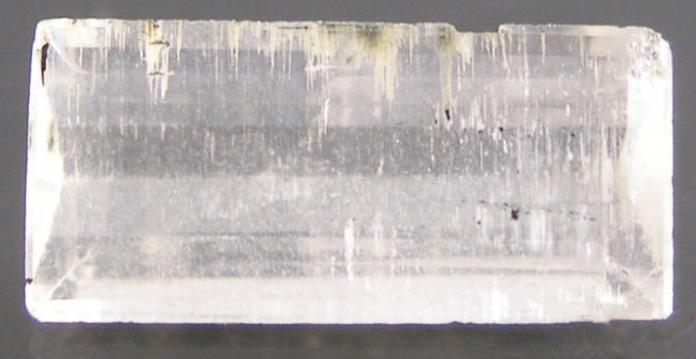Beryllonite
Beryllonite is a rare sodium beryllium phosphate mineral. It has the chemical formula NaBePO4 - sodium beryllium phosphate. Beryllonite was first discovered in 1888 by James Dana and derives its name from the beryllium element it contains in large proportions. [1]

Beryllonite
(faceted, from Brazil. Weight: 0.18 carats)
Image © supplied by Woodmansee* Gems
Beryllonite Properties:
The crystals of Beryllonite have the composition of sodium beryllium phosphate. The molecular weight of Beryllonite is hence 127 grams. The crystals of Beryllonite contain 18 percent of sodium, 7 percent of beryllium and 50 percent of oxygen. The crystals of Beryllonite are classified as phosphates mineral. The crystals of Beryllonite display monoclinic prismatic properties and occur as tabular crystals in the natural form.
Beryllonite in its natural form can occur as tabular to short prismatic crystals. It is also often seen in the form of spherical aggregates, fibrous or massive (i.e. a shapeless mass) habit.
Twinning of the crystals of Beryllonite is extremely common. The twinning in the crystals of Beryllonite occurs as polysynthetic (multiple twins aligned in parallel) [2] , also with contact and penetration of one twin into the other.
Beryllonite, like most rare earth gemstones, is quite brittle with hardness of 5.5 on the Moh’s hardness scale. The crystals also display conchoidal fractures which contributes to the brittle nature of the Beryllonite. The crystals however are quite dense with a density of 7 g/cm3. Beryllonite, unlike many other gemstones, is not very soluble in hot and concentrated acids. It often takes few hours and constant heating and stirring of the acids for the crystals to completely dissolve. Beryllonite crystals on dissolving change into herderite.
Beryllonite generally occurs in the colors of white or as transparent colorless crystals in the natural form. Pale yellow crystals of Beryllonite also occur but are extremely rare. The crystals range in luster from sub-vitreous, resinous, waxy or greasy. [3]
Beryllonite is not typically cut as a gemstone - however it has been done, as evidenced by the image top left. As beryllonite has a refractive index that is not particularly high (no higher than quartz), it is not very brilliant as a gemstone. Although beryllium is classified as a rare mineral , the crystals of Beryllonite are not popular in the common gemstone markets across the world because the crystals of Beryllonite typically lack hardness, fire and color. However their rarity and uniqueness means they do have some interest to collectors of rare minerals.
Beryllonite has also been found in chatoyant (cat's eye) form. [4]
Beryllonite - Occurrence:
The crystals of Beryllonite were first found in 1888 in the Sugarloaf Mountain mines in Maine, USA. Since then it has been found in the Konar and Nuristan Provinces of Afghanistan. [3] The crystals of Beryllonite are also found in limited amounts in Minas Gerais in Brazil. Small amounts of Beryllonite are also found in several other countries including France, Portugal, Finland, Canada, Sweden and England (Devonshire). The finest quality crystals of Beryllonite that have been discovered are said to be those occuring in Paprock, in the Laghman Province in Afghanistan. The crystals of Beryllonite procured from the Laghman Province are extremely clear to the eye and bright. The largest known crystal of Beryllonite was found in the Laghman Province of Afghanistan.
The crystals of Beryllonite are generally found in granite depositions and alkaline pegmatites. The Beryllonite crystals are also found in deposits of rare secondary minerals. Beryllonite has been found in association with herderite, triplite, apatite, eosphorite, morinite, lithophilite, elbaite, pollucite, petalite, lepidolite, orthoclase, quartz, Smoky Quartz, Muscovite, Microcline, Fluorapatite, Cassiterite, Beryl, Albite, Feldspar, and columbite. [3] [5]

Beryllonite
(faceted, from Brazil. Weight: 0.88 carats)
Image © supplied by Woodmansee* Gems
Back to the Gemstones List home page - over 160 gemstones explored!
Beryllonite - Sources Referenced:
[1] http://en.wikipedia.org/wiki/Beryllonite
[2] http://en.wikipedia.org/wiki/Crystal_twinning
[3] http://www.mindat.org/min-644.html
[4] http://www.realgems.org/list_of_gemstones/beryllonite.html
[5] http://rruff.geo.arizona.edu/doclib/hom/beryllonite.pdf
Please feel free to link to this page - copy / paste the text below: (click to select)
Privacy Policy | Cookie Policy | GDPR | About This Site / Terms

© gemstoneslist.com


